Exhibits put up by prisoners after the Buchenwald concentration camp was liberatedA display table put up by the Buchenwald prisoners, shown in the photo below, featured a lamp shade allegedly made from human skin, two shrunken heads allegedly made from the severed heads of two Polish prisoners, an ashtray made from a human pelvis bone, and several pieces of human skin with tattoos. Note the man in the center of the photo who is still wearing his prisoner's badge with a red triangle, indicating a political prisoner. 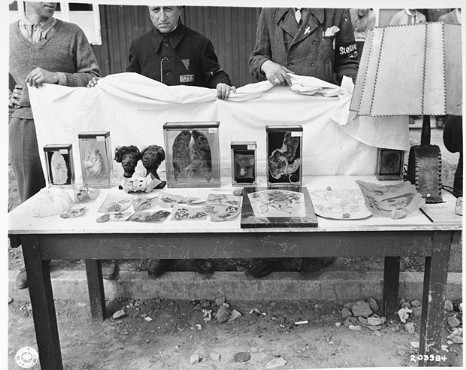 A series of videos about Buchenwald on this web site includes a video about the display in the photo above. 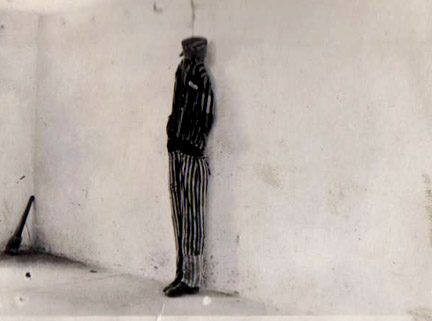 The photo above is an exhibit that was set up inside the morgue at Buchenwald. At Dachau, the dead bodies of prisoners were hung from pulleys above the ovens so that the bodies would remain straight before rigor mortis set in. At Buchenwald, the morgue was allegedly used as an execution room where live prisoners were hung from hooks on the wall until they were dead. In the photo, there is a hook on the wall above the head of what looks like a dummy dressed in a prisoner's uniform. In the corner is what looks like a club; perhaps this is the "bloodstained club" that was found in the morgue by the liberators, according to the Buchenwald Report. Note the marks on the wall, which could be the "heel marks" that one of the American liberators reported seeing. According to the Buchenwald Museum, the youngest prisoner who was executed at Buchenald by hanging from a hook in the morgue was eight years old, although Germany had a law that prohibited the execution of prisoners below the age of sixteen. The Buchenwald camp also had a gallows where prisoners who were condemned to death were hung. It was customary for the Nazis to send criminals who had been convicted in a court of law to the nearest concentration camp to be executed. 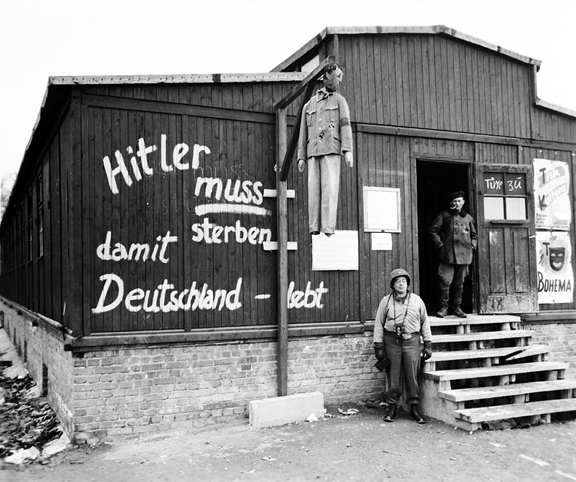 The photo above, taken after the camp was liberated, shows an American soldier with a camera around his neck and a well-dressed prisoner standing at the entrance which has a sign that reminds visitors to shut the door. The translation of the words on the wall of the building read: "Hitler must die so that Germany can live." On April 30, 1945, the prisoners got their wish when Hitler committed suicide. The display in the photo below depicts the punishment called "tree hanging," which was devised by Martin Sommer, the SS officer who was in charge of the bunker, or the camp prison. This punishment was reserved for serious offenses such as sabotage in the factories at Buchenwald, where the prisoners were forced to work. It was discontinued in 1942 by order of Reichsführer Heinrich Himmler, who was the head of all the concentration camps. 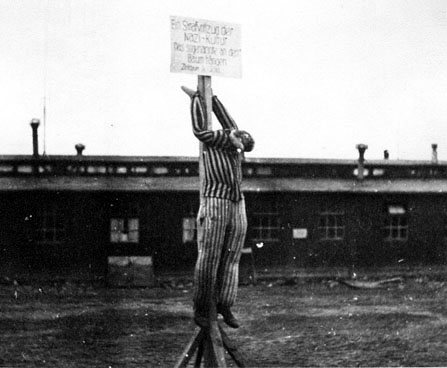  The words on the sign, shown in the photo above, are "Ein Strafvollzug der Nazi-Kultur: Das sogenannte an den Baum hängen." The last two words are illegible. The English translation is "A Punishment of Nazi Culture: The so-called hanging on a tree." Martin Sommer, the alleged innovator of this cruel punishment, was put on trial by SS officer Dr. Georg Konrad Morgen in a Nazi court in 1943 at the same time that Buchenwald Commandant Karl Otto Koch and his wife Ilse were put on trial by the Nazis for embezzlement and abuse of the prisoners at Buchenwald. After the trial, Sommer was transferred to the Russian front where he was wounded in action. Sommer was again tried by a West German court in 1958. Sommer, who was a paraplegic as a result of war wounds, was convicted of the murder of 25 Buchenwald prisoners by injection and was sentenced to life in prison. 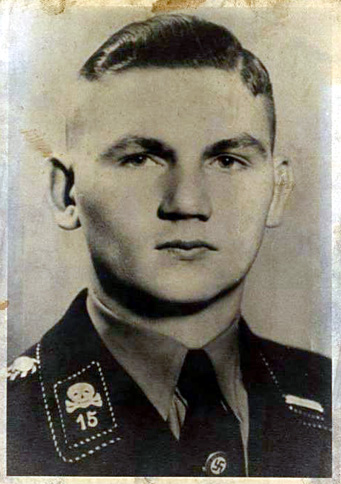 The photo below was taken in the Museum at Dachau in May 2001. The photo, which is a recreation of the tree hanging punishment at Buchenwald, is not included in the new Museum at Dachau which opened in May 2003. 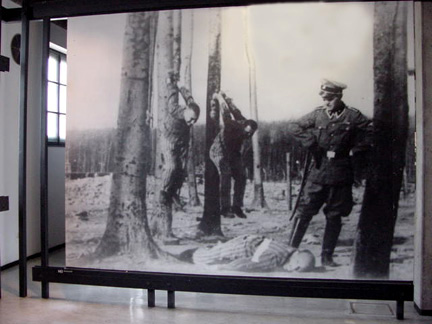 According to Harold Marcuse, Professor of History at the University of California at Santa Barbara, this scene was created in 1958 for an East German DEFA film, which is why the photo is no longer used. Reference: H. Obenaus, "Das Foto vom Baumhängen: Ein Bild geht um die Welt," in Stiftung Topographie des Terrors Berlin (ed.), Gedenkstätten-Rundbrief no. 68, Berlin, October 1995, pp. 3-8. More exhibits at BuchenwaldBuchenwald OrphansCongressmen & ReportersEdward R. Murrow ReportLiberation ClaimsLiberation DayBuchenwald SurvivorsGerman civilians tour BuchenwaldBack to Buchenwald LiberationHomeThis page was last updated on June 25, 2010 |